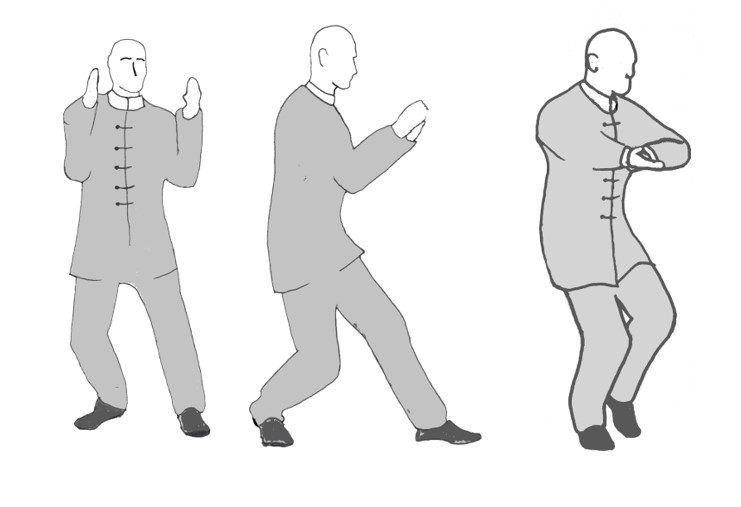
There are a numerous stances in Taijiquan, but when starting out we first learn the Bow Stance, Sitting Stance and T-Stance. Of course we always start our routine with Wu Ji stance or posture, also known as quiet standing. These are foundational to all our Taijiquan routines.
This blog is intended for the beginner but also as a refresher for the more experienced practitioner. It is of benefit to regularly check your stances to avoid bad habits and the possibility of injury particularly where the knees are concerned.
Wu Ji stance
This stance is achieved by standing with the feet together but not touching, and with your knees off lock. The toes of the feet lightly grasp the ground through your shoes. The whole body is relaxed with the head held erect as if suspended by the crown from the sky. The chin should be very slightly tucked in to help align the the spine. Your back should be straight but not tensed such that your backside isn’t sicking out. The shoulders should be relaxed and very slightly rolled forward such that your aren’t standing in military position with your chest stuck out. The arms should hang freely with the middle finger of each hand lightly touching the thigh. This should all be done in a relaxed manner. Your muscles should be completely relaxed other than that effort required to maintain your standing posture. Bring your attention into the body and focus this on your breathing once the body is relaxed.
To add more depth to Wu Ji stance, you may like to let the eyes become unfocused but looking into the distance. Breathe in through the nose and out through the mouth. Lift the tongue to lightly touch the upper palette behind the top teeth. As you stand in quiet standing focusing on your breathing let go of any thoughts that arise. This is a time to prepare the body-mind-breath and achieve stillness thus readying us for our Taijiquan practice.
Bow stance – left

This picture best illustrates the Bow stance
When in a Bow stance the weight should be distributed approximately 70% on the front foot and the balance on the back foot. The separation of the heels should be approximately shoulder width apart (as shown above in the foot placement diagrams). It is important that the knee of the front leg is inline with that foot and does not extend beyond the line of the big toe. The knee of the rear leg should be off lock with the leg straight. The torso should be vertical, the back straight but relaxed, and the hips to the front. Relax the muscles in your body until they are only holding you in position and nothing more. Imagine your head is suspended from your crown, and the chin very slightly tucked in. Eyes looking straight ahead but unfocused.
Sitting stance

This stance is simply achieved by relaxing the knee of the back leg and shifting the weight back onto that leg from the Bow stance above. So now the front leg is straightened with the knee off lock. The knee of the rear leg should be bent and in line with the toes of that foot, but not extending beyond the toes. Look down to check this alignment as pulling the knee in or pushing the knee out will eventually result in knee soreness and possible injury. 70% of your weight is now on the rear leg and 30% on the front.
‘T’ stance – left

The T stance is an intermediate stance or step that is used initially to keep your balance when stepping through as you are performing Tai Chi walking. All the weight is on the left foot which is turned out at an angle of 45 degrees. The toe of the right foot very lightly touches the ground close to the heel of the left foot. The knee of the right leg faces straight ahead. It is important that you do not bob up as you step into the T stance, maintaining the height set by the previous bow stance
The stances are exactly the same, but in mirror image when done on the right side. Knee alignment is critical to avoid injury and should be checked regularly when first learning. If you notice some knee soreness do not hesitate to get your instructor to check your stances. When first practicing these stances it is not uncommon to feel some fatigue in the quadriceps muscles and possibly a little delayed onset muscle soreness the next day. This is no different from that which you may experience when commencing any new form of exercise. These stances combined with Tai Chi walking will lead to very strong legs and greatly improved balance.
Yours in Taijiquan and Qigong